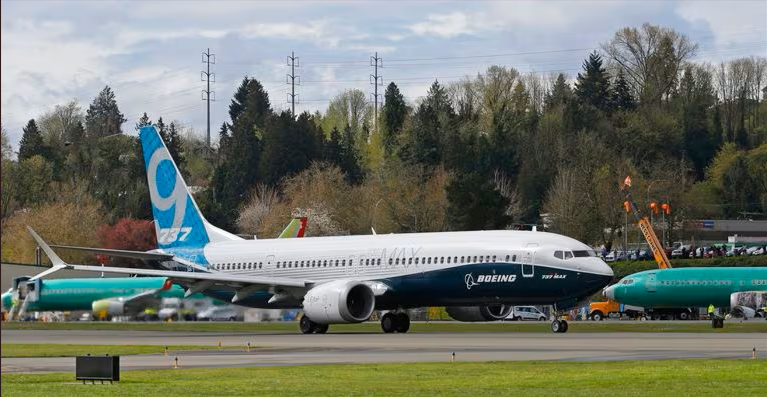Alaska Airlines voluntarily grounded its complete Boeing 737-9 Max fleet even before the Federal Aviation Administration issued an order to ground over 100 aircraft of the same model on Saturday.
As per the airline’s official statement released on Saturday evening, numerous passengers sustained injuries necessitating medical attention following a catastrophic blowout of a window and fuselage over Portland, Oregon.
The distressing incident unfolded on Friday when a window panel disintegrated on an Alaska Airlines Boeing 737-9 Max merely seven minutes after departing from Portland. The sudden decompression forcibly stripped a child’s clothing and triggered the release of oxygen masks from the ceiling. Remarkably, the skilled pilots executed a secure emergency landing with 174 passengers on board.
Alaska Airlines refrained from specifying the number of injured passengers or the severity of their injuries, only stating that “all guests have now been medically cleared.”
The airline, in response to the crisis, declared its decision on Friday to temporarily ground its 65 Boeing 737-9 Max aircraft, initiating inspections that commenced early on Saturday. The National Transportation Safety Board has confirmed its intention to conduct a comprehensive investigation.
Subsequent to Alaska Airlines’ proactive grounding of its Boeing 737 Max fleet, the Federal Aviation Administration issued an emergency order on Saturday, mandating the temporary grounding and immediate inspections of Boeing 737 Max 9 planes operated by U.S. airlines or flown in the United States by foreign carriers. This directive impacts approximately 171 planes worldwide.
The afflicted Max 9 aircraft, received by Alaska Airlines in October, is a recent addition, having commenced passenger operations in November with a modest 145 flights, as per Flightradar24, a flight-tracking service. The Boeing 737 Max series, comprising versions 8, 9, and 10, varies mainly in size and represents the latest iteration of Boeing’s renowned 737, frequently employed on domestic U.S. flights.

A witness, Evan Smith, recounted the traumatic experience of a boy and his mother sitting in the row where the window blew out, resulting in the child’s shirt being sucked out of the plane.
Amidst the aftermath, Alaska Airlines CEO Ben Minicucci expressed anticipation that the inspections would conclude “in the next few days.” The Max 9 aircraft under scrutiny account for over a quarter of Alaska’s fleet. Consequently, the airline disclosed that, due to the grounding and inspections, a total of 160 flights were canceled, affecting approximately 23,000 passengers.
“We are collaborating with Boeing and regulators to fathom the circumstances… and will disseminate updates as more information becomes available,” stated Minicucci. “My heartfelt sympathy goes out to those who were on this flight – I extend my sincere apologies for what you experienced.”
Portland International Airport witnessed long queues on Saturday as passengers sought alternative flights. Annette Morales, whose Alaska Airlines flight to California was delayed by four hours, commented on the inconvenience, stating, “It’s just a little bit inconvenient. Having to sit here three or four extra hours at the airport… it’s not optimal.”
United Airlines, also operating a sizable fleet of 737-9 Max jets, refrained from making any immediate announcements regarding its Max fleet.
Alaska Airlines Flight 1282, departing from Portland at 5:07 p.m. on Friday, en route to Ontario, California, experienced the window and fuselage blowout approximately three miles above Oregon. The emergency unfolded about six minutes into the flight, compelling one of the pilots to declare an emergency and request descent clearance to 10,000 feet for safe oxygen levels.
Passengers onboard captured footage of the gaping hole left by the blown-out window, displaying fellow travelers wearing their oxygen masks. The plane landed safely about 13 minutes after the incident, receiving applause from relieved passengers. Firefighters attended to the injured passengers as they remained seated.
Photographs revealed the breach in the Alaska jet where an emergency exit is usually installed for planes configured to carry maximum passengers. Due to the specific seating capacity of Alaska’s 737 Max 9 jets, these emergency exits remain plugged.
The involved aircraft, certified merely two months ago, had completed 145 flights since entering commercial service on Nov. 11. The flight from Portland marked its third journey of the day.
In response to the incident, Boeing issued a concise statement, acknowledging awareness and pledging collaboration with the airline customer. Boeing’s technical team stands ready to assist in the investigation.
The Boeing 737 Max series faced previous challenges, notably with fatal crashes in Indonesia in 2018 and Ethiopia in 2019, leading to a global grounding for nearly two years. Boeing incurred substantial financial repercussions and settled a criminal investigation in 2021.
The recent incident adds to a series of challenges for the Max, ranging from component issues to advisories on anti-ice systems and inspections for potential loose bolts in the rudder-control system. The resilience of the Max series faces renewed scrutiny, bearing the weight of a turbulent history and ongoing concerns.
